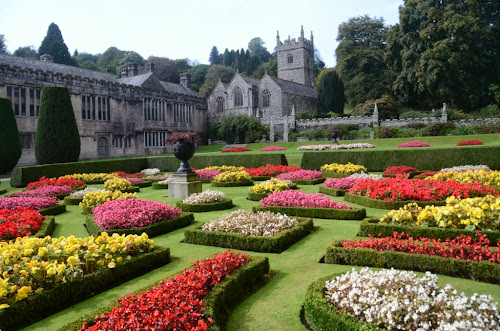Really enormous 19th century house surrounded by acres of green, impressive gatehouse, a blaze of color in the front gardens and the sun is shining when we arrive at Lanhydrock. Although it is a centuries old location, a fire required some rebuilding and the larger and grander style of the 1880s was chosen. As a National Trust site it promised a tour of fifty rooms with docents dressed in period costumes describing the working of this large estate. As we approached the front door a volunteer offered a quick ten minute introduction before entering. Gathering six or eight people he pulled out a stack of index cards and began to haltingly read as if he had never seen his notes before. Slinking away after a few moments, we were warmly greeted in the entry by a lovely woman dressed in a floor length mauve and black gown. Although the house was well staffed only one kitchen volunteer was willing to leave the comfort of his chair and interact with all of the intruders. In spite of the lack of information I did find the house interesting. Just the kitchen alone was divided into eight rooms including the kitchen, the scullery, the bakehouse, the pastry room, the pantry room, the meat larder, the dairy scullery and the dairy. I can't imagine the size of the staff! The noble who rebuilt the house was the father of ten. A separate nursery wing was built for the children, their nurses and teacher. The children and their caretakers rarely left the area, even cooking and eating meals in isolation. The long gallery, 116 feet long, which serves as the library is not the cozy, curl up in an armchair in front of the fire type of room. It does have a plastered barrel ceiling finished before the 1642 Civil War which is a intricately detailed depiction of Old Testament history.
We sat beside the sea in Fowey for a late lunch. The harbor has two docking areas for boats. Close into the sea wall are the smaller, older fishing vessels. Further out in the opposite direction are rows of large, shiny recreational sailing and power driven crafts. Sitting all along the boardwalk are people eating their fish and chips and enjoying the sunny afternoon. A small vehicle ferry carried us across the river in ten minutes and we were back on the road.
Our afternoon to-see list included tracking down a few monuments on Bodmin Moor, then moving on to Dartmoor to explore several more, en route to dinner with Mike's sister Lynda and her husband Steve. However, our list failed to acknowledge the fact that there are only twenty-four hours in a day and the roads are narrow, winding and slow with sheep, cattle, and horses sharing the road. Our unplanned leisurely lunch only made this situation worse. Bodmin Moor was scratched from our plan and we zipped towards Dartmoor, figuring we had about an hour to drive 20 miles across it and see some sights on the way. Wonderful moorland scenery, apart from the horrendous prison, but 'some sights' turned out to be two; the ancient Clapper Bridge, comprised of huge flat granite slaps resting on stone pillars, and the picturesque village of Widecome-in-the-Moor which features in an English nursery rhyme.
Our intended time for emergence from Dartmoor had long passed by the time we reached faster roads with another 30 miles to Lynda's, so Mike upped our cruising speed to 80 mph as we flew past Exeter and on to Honiton. No time to buy the dinner wine, so we arrived empty-handed.






No comments:
Post a Comment